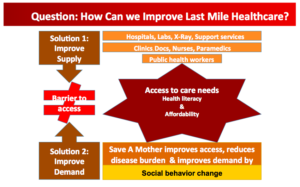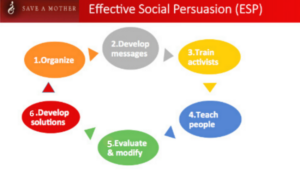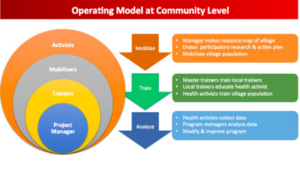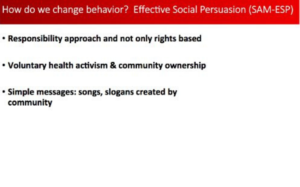Since 2008 Save a Mother (“SAM”) Foundation has developed an Effective Social Persuasion (SAM-ESP) model for health care advocacy and behavior change for the poor in India. The SAM model has been proven in over 3200 villages & 2 urban slums in 10 districts representing approximately 6.2 million people in the states of Uttar Pradesh, Telangana and Karnataka. For less than 25 cents or 15 Rupees per capita per year, SAM has dramatically improved health outcomes in underserved rural areas.
Following our SAM-ESP model, in 3 years our programs show effective results:
* Based on our work since 2008, maternal deaths were reduced by 90% and neonatal deaths were reduced by 57%.
* The successful ESP method used to curb maternal mortality has been utilized for other healthcare issues such as tuberculosis detection and population stabilization.
* TB detection has gone up to 300% and treatment completion under supervision is close to 100%.
* In SAM population stabilization program, contraceptive acceptance has increased by 220%.
By partnering with local health organizations and governmental authorities, SAM ensures the sustainability of its solutions. SAM implements its programs at a low cost – approximately 15 Rupees per village per year.
Step One: Organize the Structure and Build Capacity
Step Two: Develop Messages for Health Literacy
Step Three: Train Health Activists
Step Four: Teach People
Step Five: Cooperate with Public Health Workers
Step Six: Evaluate and Improve
Step Seven: Develop Solutions and Replicate
FAQ about SAM Effective Social Persuasion Platform (SAM-ESP)
What problem does the SAM-ESP innovation address ?
Communities with poor resources suffer from a high burden of diseases, which are either preventable or curable. We address multiple such problems: Maternal Health, Child Health, Population Stabilization, Adolescent Health, TB control, Malnutrition. We develop frugal solutions for the healthcare of the poor.
What is the SAM solution to address this problem?
We focus on the demand side of healthcare by improving health-seeking behaviour, which is the least expensive method of reducing the disease burden of a community.
We have developed an Effective Social Persuasion model for social behaviour change, which creates intelligent demand from the community. We have successfully tested and replicated the solution in 10 different locations (districts in India) in the last 11 years
What does it do and how is it delivered?
We have developed an Effective Social Persuasion Platform (SAM-ESP). This low-cost platform persuades a community to modify its health-seeking behaviour. The program is simple, sustainable and scalable with speed. SAM-ESP is based on two assumptions:
• Health is an individual and community responsibility; ownership of this responsibility promotes health and empowers a community to demand healthcare rights. Denial of responsibility transfers the burden of the solution to an external agency to provide a supply-side solution, which is expensive.
• A sustained campaign can persuade a community to modify health-seeking behaviour. Peer to peer nudge is more effective than the provider-client persuasion method.
SAM-ESP uses the following steps for behaviour modification.
• We develop simple messages to change behaviour
• We train community volunteers as health care leaders and knowledge partners
• We deliver these messages as stories, illustrations, graphics, videos and entertainment education at group meetings and at individual counselling
• The community creates own culture-specific messages as songs and slogans
• Repetitive messaging, peer to peer messaging and community involvement are three key elements for behaviour change
• We reinforce positive behaviour by illustrating sickness events which could be avoided through behaviour change.
• The community leaders take over to own the program after 3 to 5 years.
• We solved the unmet need for contraception by improving the supply chain. We appointed 292 sales depots, run by village women, where contraceptives are readily available below the market price. The women prefer these shops as it protects their privacy.
How is SAM innovation different?
- Awareness is often assumed to be equal to behaviour change. In practice, it is not so. Prevalent awareness-building programs merely touch the surface without translating into measurable behaviour change. Our program is a multi-step process, where awareness is one of many steps for a sustainable behaviour change.
- Our field workers are from the community where they live and work. They are available 24/7. We take health to the village centre and to the doorstep of recipients.
- We promote ownership of both health and healthcare. We believe, health is an individual and community responsibility and healthcare is a right.
- Our program has no predetermined endpoint. Our repetitive training continues until we meet our targets.
- We develop a cadre of volunteer village health activists who take over the program after we succeed. We also develop a cadre of social entrepreneurs, who sell contraceptives, sanitary pads, and nutritional products.
- Ours is a sustainable peoples program, which makes the health system more responsive.





